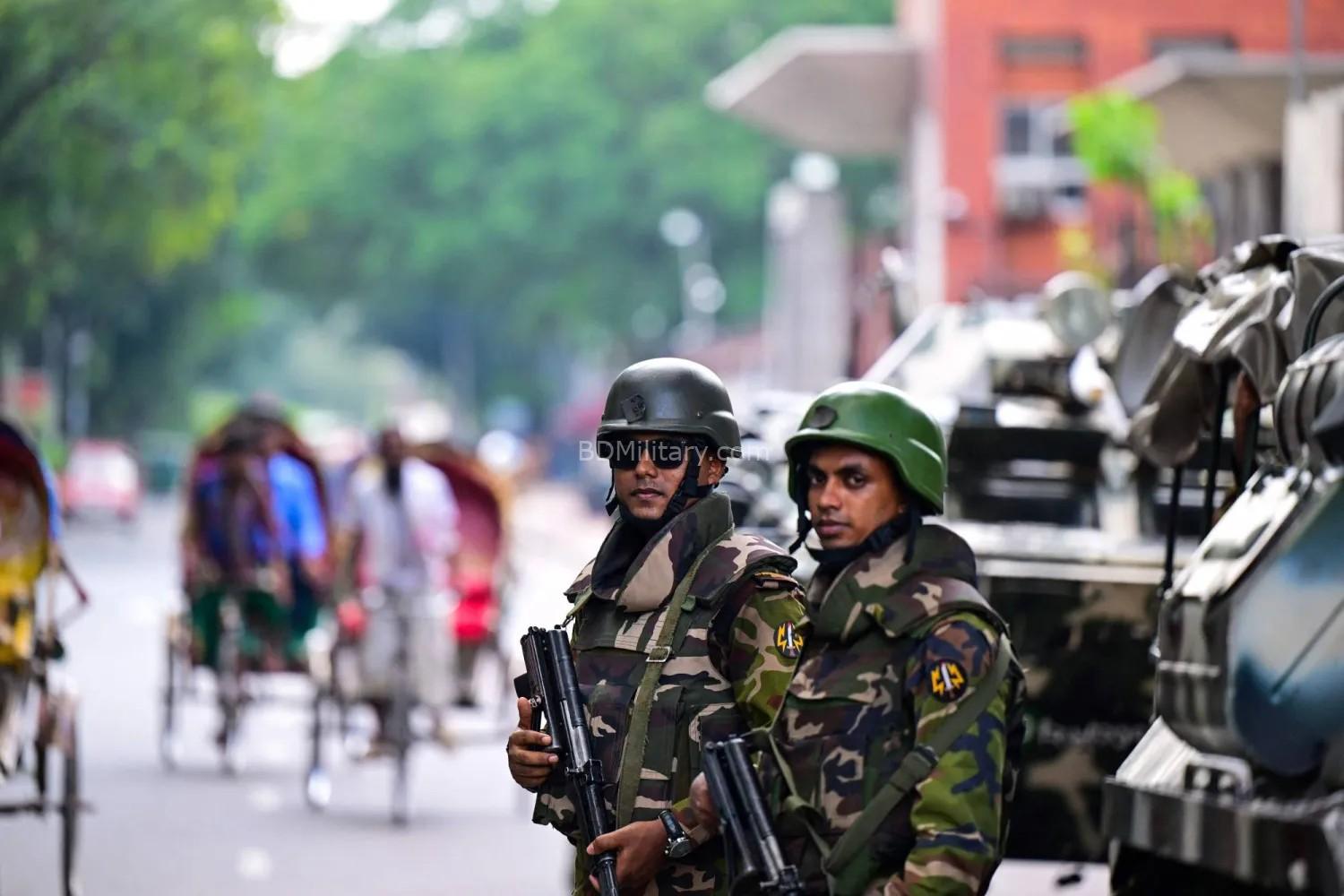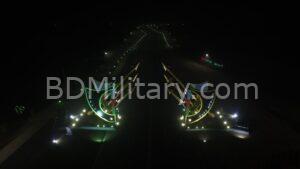Editorial Excerpt
Conventional wisdom says Bangladesh’s lack of strategic depth is a weakness. In reality, its rivers, people, and partnerships make it one of the hardest countries in Asia to invade. This analysis explores how Bangladesh’s geography, manpower, and diplomacy together create a formidable multi-layered deterrent.
Introduction: Rethinking a Classic Vulnerability
Strategic depth — the ability to trade space for time in war — has long been seen as a cornerstone of military survivability. Nations with vast hinterlands can absorb blows, regroup, and counterattack. For states like Bangladesh, whose borders hug the sea and whose terrain offers little physical depth, this concept has often been labelled a weakness.
Yet in Bangladesh’s case, that assumption is outdated. The nation’s blend of dense population, complex riverine geography, vast manpower reserves, modernising forces, and strategic diplomatic balance make it far more resilient than geography alone suggests. What Bangladesh lacks in landmass, it more than compensates for through other forms of depth — human, hydrographic, and strategic.
The Population Factor: When Density Becomes Defence
Bangladesh is one of the most densely populated countries in the world — and paradoxically, this is a deterrent in itself. An invading force would have to fight not on empty plains but in crowded towns, villages and cities where every street and every bridge teems with people.
The humanitarian, political and logistical costs of such an operation would be staggering. Civilian presence would limit the use of heavy weapons, while collateral damage would invite international condemnation. For the occupier, even a tactical advance would require enormous resources just to maintain control over hostile urban areas.
No state with nearly two hundred million inhabitants can be “occupied” in any traditional sense without catastrophic losses and political fallout. Bangladesh’s population density, rather than a liability, is a powerful form of passive deterrence.
Rivers, Marshes and Deltaic Terrain: The Natural Fortress
Few countries are shaped by water as profoundly as Bangladesh. Over 700 rivers and tributaries carve up its land, creating an ever-changing mosaic of floodplains, islands and marshlands. To an invader, this is a logistical nightmare.
Each river crossing would require specialised equipment, coordination and timing. Typical bridging units and armoured recovery vehicles are insufficient; the invader would need full-scale brown-water naval capability — shallow-draught assault boats, ferries, and amphibious logistics — simply to move divisions across terrain the defenders know intimately.
In effect, Bangladesh’s rivers act as a natural anti-access system, fragmenting any offensive momentum. Geography here serves as a silent ally, complicating every thrust and protecting the nation’s interior like a web of liquid barriers.
Airborne Operations: High Risk, Low Return
Some may argue that an aggressor could bypass these obstacles through airborne or airmobile landings. In practice, such operations would only produce isolated pockets of lightly equipped troops, vulnerable to encirclement and attrition.
Airborne forces excel at surprise, not occupation. Sustaining them in Bangladesh’s humid, river-crossed terrain — without secure airfields or ground corridors — would be nearly impossible.
Moreover, today’s Bangladesh is not the Bangladesh of 1971. The country now fields a multi-layered air defence network, integrating Chinese, Turkish and French systems to deny hostile airspace and protect vital assets. Airborne insertions without air superiority would be suicidal, and even temporary lodgements could be rapidly neutralised.
Economic and Diplomatic Deterrence: The Cost of Aggression
Bangladesh is no longer a marginal economy but a $500 billion player positioned at the crossroads of South and Southeast Asia. It sits astride the northern Bay of Bengal — one of the world’s most vital maritime corridors — making its stability a concern for powers far beyond the subcontinent.
Any aggression against Dhaka would therefore be a geopolitical shockwave. China and the United States both view Bangladesh as strategically important, while India, the Gulf states, Japan and ASEAN nations have deep economic stakes in its prosperity.
An invader would not only face military resistance but also swift economic and diplomatic isolation, sanctions, and supply chain disruptions. The reputational and financial fallout alone would outweigh any conceivable territorial gain.
Regional Ties and Strategic Partnerships
Bangladesh’s defence diplomacy has matured considerably. It maintains robust military cooperation with Türkiye and Pakistan, enjoys strong defence-industrial and training links with China, and participates actively in UN peacekeeping — relationships that enhance both its credibility and deterrent posture.
These partnerships complicate the calculus for any aggressor. A hostile act against Dhaka would not occur in a vacuum; it would invite condemnation and possibly active countermeasures from its defence partners. Moreover, history shows that foreign aggression often unites Bangladesh’s diverse political spectrum, rallying the population in defence of sovereignty and erasing internal divisions overnight.
The Economic Impossibility of Occupation
Even if an invader somehow gained a foothold, holding Bangladesh would be ruinously expensive. Sustaining occupation forces across broken terrain and dense cities would drain any aggressor’s treasury. The costs of reconstruction, humanitarian administration, infrastructure control and constant counterinsurgency would dwarf the value of any conquest.
In today’s interconnected global economy, the aggressor’s own supply chains, export markets and diplomatic relationships would suffer. Occupying Bangladesh would be an economic suicide mission as much as a military one.
Manpower as Strategic Depth
Where Bangladesh truly compensates for geographic limitation is in human mobilisation potential.
Beyond its regular armed forces, the country maintains an enormous network of paramilitary and auxiliary formations. These include the Border Guard Bangladesh (BGB), Bangladesh Coast Guard (BCG), Ansar and Village Defence Party (Ansar-VDP), and heavily armed police formations such as the Rapid Action Battalion (RAB) and Armed Police Battalion (APBn).
Together, these forces represent at least 6.7 million trained or semi-trained personnel, capable of local defence, policing and combat support. Their distribution — from borders to villages — gives Bangladesh a truly national security lattice that is difficult to disrupt.
In wartime, the country could mobilise up to 70 million people for national defence and auxiliary services. This figure includes reserves, civil defence volunteers, technical specialists and logistical manpower. Such an immense pool ensures that Bangladesh can convert population density into combat depth.
In strategic terms, the nation’s “depth” is not territorial but human — a reserve of determination and manpower that would turn any invasion into a protracted war of attrition.
Asymmetric and Irregular Defence Advantages
Bangladesh’s security forces are not strangers to asymmetric warfare. Decades of peacekeeping, counterinsurgency and disaster response have produced a military establishment highly adept at operating in difficult conditions with limited resources.
Should a foreign power attempt occupation, Dhaka could rely on irregular warfare, guerrilla tactics and urban resistance, all supported by vast local networks. Its population’s patriotism and organisational structure — from village-level Ansar units to district defence committees — mean any invader would face a continuous, nationwide insurgency.
This human and institutional resilience is Bangladesh’s real strategic depth — one measured not in kilometres, but in the persistence of its people.
Lessons from History: When Great Powers Faltered
History repeatedly demonstrates that military sophistication does not guarantee strategic success. Some of the most formidable armies in history have failed to subdue nations that, on paper, appeared weaker or less developed.
The Soviet invasion of Afghanistan (1979–1989) stands as a classic example. One of the world’s two superpowers, equipped with tanks, aircraft, and modern logistics, found itself defeated by lightly armed Afghan fighters who leveraged terrain, mobility, and local support. The campaign drained Soviet morale and coffers, helping precipitate the collapse of the USSR itself.
Similarly, during the Vietnam War, the United States — at the height of its military power — faced an enemy with inferior equipment but unmatched endurance and understanding of the terrain. Despite winning most battles, the U.S. lost the war, proving that strategic victory belongs to those who can outlast and out-adapt their adversaries, not merely outgun them.
The pattern repeats across eras: Nazi Germany’s failure in the Soviet Union, France’s loss in Algeria, and the collapse of the U.S.-led occupation of Iraq all underline the same truth — that occupation against a resistant population is strategically unsustainable.
Most recently, the twenty-year NATO campaign in Afghanistan showed again that technological superiority and air power cannot overcome local resilience and national will.
For an invader, Bangladesh would present a similar paradox. Its dense population, riverine geography, and patriotic culture would transform any invasion into a long, bloody, and politically ruinous quagmire. History shows that no external power can easily suppress a nation fighting for its own soil — a lesson that remains as relevant today as ever.
Historical Lessons and Modern Realities
The 1971 Liberation War remains an emotional and historical touchstone, but the strategic context today is entirely different. Modern Bangladesh is more populous, more connected, and better armed. Global media scrutiny, international law, and multilateral diplomacy ensure that acts of aggression no longer occur unnoticed or without consequence.
In an age where information travels faster than armies, even limited incursions can trigger worldwide condemnation and coordinated sanctions. Modern warfare’s political dimension — amplified by global visibility — makes overt invasion practically untenable.
The Evolving Force: Modernisation and Balance
Bangladesh has pursued a measured and balanced modernisation of its armed forces. It has invested in precision artillery, advanced radar networks, naval aviation, and integrated air-defence systems. Its naval and riverine forces are steadily expanding with indigenous shipbuilding and foreign partnerships, ensuring control over its maritime and deltaic approaches.
This layered defence model — combining geography, manpower, and technology — ensures that no single vulnerability can be exploited decisively. The country’s policy of diversified procurement also prevents overreliance on any one foreign partner, reinforcing strategic autonomy.
The New Meaning of Depth
Strategic depth, as a concept, was born in an era of land empires and armoured thrusts across open plains. For 21st-century Bangladesh, the term must be redefined.
The country’s rivers, people and partnerships provide a different kind of depth — one that turns apparent vulnerability into resilience. Any adversary contemplating aggression would confront not an undefended delta, but a nation with millions of trained defenders, a complex riverine fortress, a united population, and a network of allies ready to act.
Far from being shallow, Bangladesh’s strategic posture runs deep — not through miles of territory, but through layers of deterrence woven into its society, economy, geography and diplomacy.
In short, Bangladesh’s true strategic depth lies in its people, its waters, and its will to defend them.

Ayesha Farid is a regional security specialist focusing on South Asia, with over a decade of experience analysing inter-state tensions, cross-border insurgency, and regional power dynamics. She has worked with leading policy think tanks and academic institutions, offering nuanced insights into the complex security challenges shaping the subcontinent. Ayesha’s expertise spans military doctrines, border disputes, and regional cooperation frameworks, making her a vital contributor to BDMilitary’s coverage of South Asian strategic affairs. She leads the Geopolitics & Diplomacy section at BDMilitary. Ayesha holds a dual master’s degree — a Master in International Relations from the IE School of Politics, Economics & Global Affairs, Spain, and a Master of Public Policy from the Munk School of Global Affairs, University of Toronto, Canada — combining deep academic insight with practical policy expertise.

